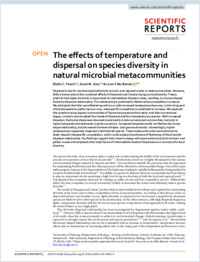The effects of temperature and dispersal on species diversity in natural microbial metacommunities
- Parain, Elodie C. University of Fribourg, Department of Biology - Ecology and Evolution, Switzerland - Yale University, Department of Ecology and Evolutionary Biology, Street, New Haven, USA
- Gray, Sarah M. University of Fribourg, Department of Biology - Ecology and Evolution, Switzerland
- Bersier, Louis-Félix University of Fribourg, Department of Biology - Ecology and Evolution, Switzerland
-
01.12.2019
Published in:
- Scientific Reports. - 2019, vol. 9, no. 1, p. 18286
English
Dispersal is key for maintaining biodiversity at local- and regional scales in metacommunities. However, little is known about the combined effects of dispersal and climate change on biodiversity. Theory predicts that alpha-diversity is maximized at intermediate dispersal rates, resulting in a hump-shaped diversity-dispersal relationship. This relationship is predicted to flatten when competition increases. We anticipate that this same flattening will occur with increased temperature because, in the rising part of the temperature performance curve, interspecific competition is predicted to increase. We explored this question using aquatic communities of Sarracenia purpurea from early- and late-successional stages, in which we simulated four levels of dispersal and four temperature scenarios. With increased dispersal, the hump shape was observed consistently in late successional communities, but only in higher temperature treatments in early succession. Increased temperature did not flatten the hump-shape relationship, but decreased the level of alpha- and gamma- diversity. Interestingly, higher temperatures negatively impacted small-bodied species. These metacommunity-level extinctions likely relaxed interspecific competition, which could explain the absence of flattening of the diversity-dispersal relationship. Our findings suggest that climate change will cause extinctions both at local- and global- scales and emphasize the importance of intermediate levels of dispersal as an insurance for local diversity.
- Faculty
- Faculté des sciences et de médecine
- Department
- Département de Biologie
- Language
-
- English
- Classification
- Biological sciences
- License
- License undefined
- Identifiers
-
- RERO DOC 327940
- DOI 10.1038/s41598-019-54866-9
- Persistent URL
- https://folia.unifr.ch/unifr/documents/308302
Statistics
Document views: 59
File downloads:
- ber_etd.pdf: 133
